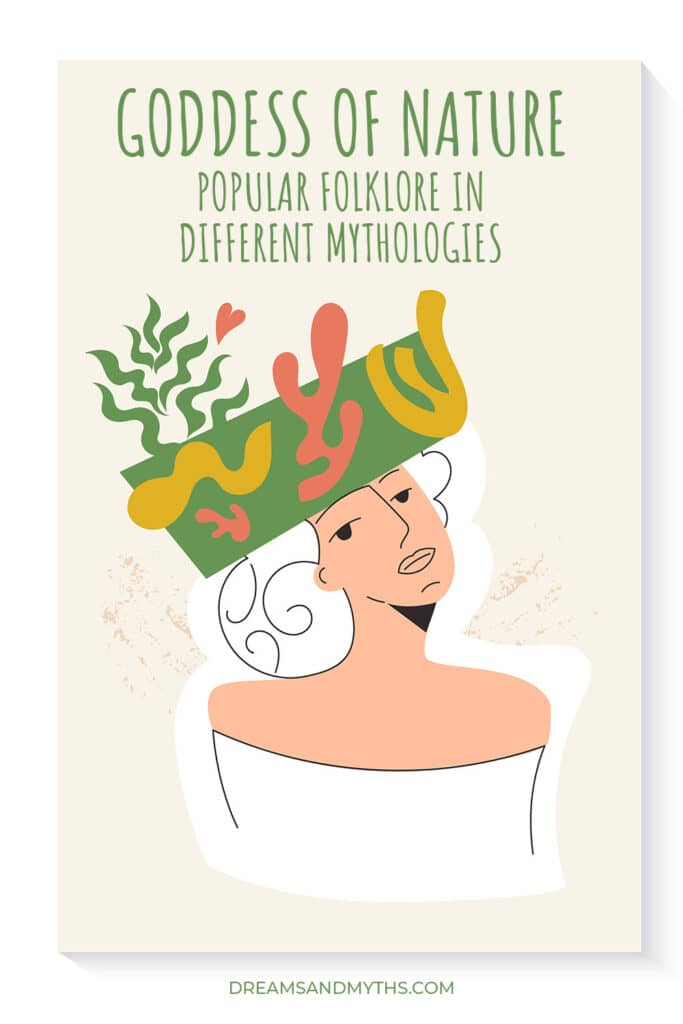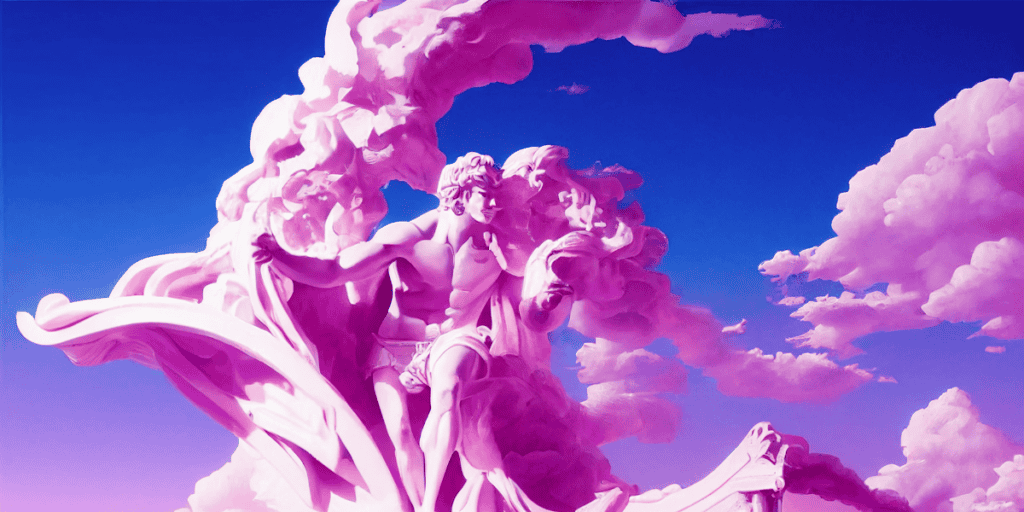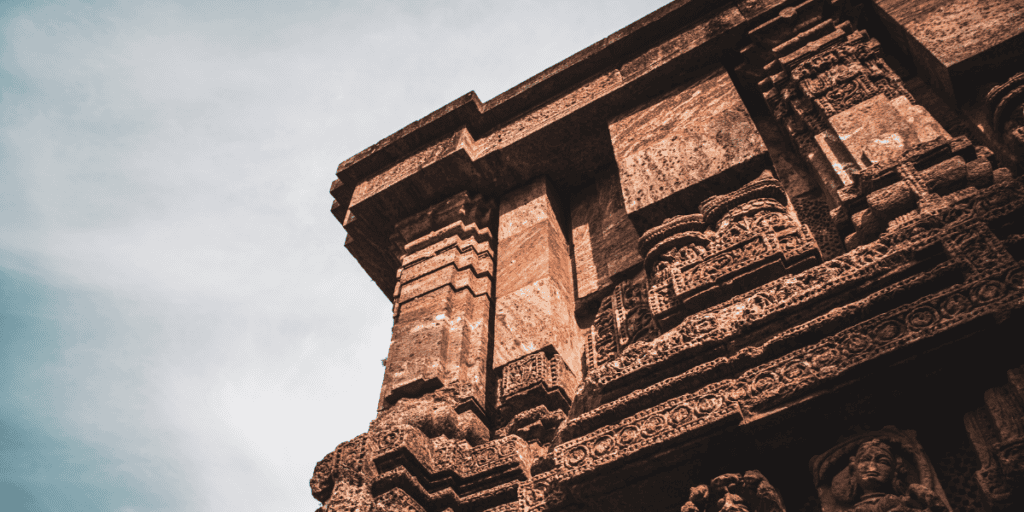It turns out that there are many amazing folklores about several recognized powerful goddesses of nature in world mythology. The stories are wonderful! We will take you through 15 incredible goddesses of nature belonging to different mythological beliefs around the world and their popular folklores.

Go on, and you will be surprised to find out that you didn’t know about a lot of them.
1. Norse Mythology
As we talk about the goddess of nature in different mythologies, let’s first know about how she is depicted in Norse mythology.
Goddess Jörð
Jörð is the goddess of earth and mother of Thor, the thunder god and Odin’s wife. Odin is the chief of Norse gods, the god of war, wisdom, poetry, and the dead who ruled over Valhalla. The Vikings heavily respected him and held Jörð in the highest esteem.
You can find her references in several quotes from skaldic poetry. Folklorist John Lindow believes that Jörð was a giantess and a goddess. However, Odin’s had many sexual relationships outside his marriage with Jörð.
So, he is believed to be the father of all gods in Christianity. This belief, however, is not just limited to the religion of Christianity. So, to put things in perspective, this lore or myth also evolved to connect earth with femininity among the pre-Indo Europeans.
It’s also believed that the union of the sky gods and the earth goddesses maintains the cosmic order and blesses the land with immense prosperity as it gets fertilized by the sun and the rain.
You may also like to read – the Norse mythology stories article link
2. Greek Mythology

Greek Mythology has an adventurous and fascinating depiction of the goddess of nature. She is known as Gaia.
Goddess Gaia
Gaia or Gaea, the Greek goddess of earth, needs a special mention here. She is the ultimate mother who is known to sustain life. It’s believed that she is the primary origin or birth of all the Greek gods. In Greek mythology, she is also the first and supreme origin from which the sky and sea, as well as all of the Titans and Giants, are born.
The legend says that the goddess Gaia was born out of Chaos. Chaos was present as the first thing of all the elements. It’s called the “gaping void,” signifying a state of complete disorder. Gaia came into being from Chaos along with several other “first” deities, such as Eros, Erebus, Nyx, and Tartarus.
Once chaos was gone, she created a child who was also her spouse named Uranus. Later, Gaia birthed many gods with Uranus. As per Hesiod’s account, Gaia, along with Uranus in the first phase, gave birth to three Cyclopes (giants with three eyes), namely Brontes, Steropes, and Arges. And in the second set of birthing, she was responsible for the origin of the Hecatonchires: Cottus, Briareos, and Gyges.
These were born with a hundred arms and fifty heads. However, cruel Uranus hid the Cyclopes and Hecatonchires in a secret place immediately after their birth, inside Gaia’s womb, which made her go through an immense amount of torture and pain.
She planned an act of revenge against Uranus and convinced her children to help her. As part of the act, she built an unbreakable sickle that Cronus used to emasculate or desex his father, Uranus. Cronus cut off his testicles when forced Cronus’s mother, Gaia, for sex.
The slaughtered organs were thrown into the sea. Gaia and the blood of Uranus together even gave birth to the Giants and the Meliae and the Erinyes. Aphrodite was formed from the testicles of Uranus and the foam in the sea.
Ceto, Phorcys, Nereus, Eurybia, and Thaumas are the popular sea gods given birth by Gaia with her own son Pontus.
In the long list of children birthed by Gaia, Titans Hyperion, Iapetus, Oceanus, Phoebe, the Python of Delphi, Crius, Coeus, Theia, Themis, Rhea, Mnemosyne, Tethys, etc., were some of the well-known ones too.
Gaia was believed to be an all-encompassing goddess in herself. So, her oath was the most powerful element, and it symbolized that nobody could escape from the creator or Mother Earth.
Bonus Read – Goddess Eirene article link
3. Celtic Mythology

The goddess of nature in Celtic mythology has a somewhat similar depiction as that of Norse mythology. She is known as Anu and symbolizes beauty.
Goddess Anu
Anu is the widely respected Celtic Earth goddess, portrayed as a beautiful woman and believed to be the mother of all Celtic gods, as well as the origin of life. She symbolizes abundance, fertility, and nurturing.
Since Anu gave birth to all life forms, she is believed to personify the earth and the water bodies on earth – the elements from which different life forms emerge or manifest.
Anu or Dana or Danu is the supreme mother of the people of Dana, also called the Tuatha De Danann – a supernatural tribe of Celtic gods who were a part of Gaelic Ireland before Christianity.
Goddess Flidais
Flidais is another popular Celtic goddess of wild flora and fauna or the lady of the forest. She has multiple symbolizations as well as stories associated with her. She is believed to love and care immensely for both wild and domestic animals, deer and cattle being her sacred animals whom she milked, making her the goddess of plenty.
Goddess Druantia
Druantia, the white goddess and the queen of the druids, is the Celtic goddess of fertility and fir trees. She is named after oak trees or wood, which means “Drus,” according to the ancient Indo-European roots of the name.
She is the daughter of the God Cleddyf and the Queen of Bees.
Her sisters Gwaeth – the wind and Gwaethav Oll – the wind of all), together they symbolize the manifestation of the main cycle of life, the three destinies: birth, growth, and death. The sisters live in the sacred grove of Aymara, the Goddess of Growing Things, Queen of Harvests, and Bride of the Oak.
Additional interesting reads for you – Mighty Celtic Gods and Goddesses – Dreams and Mythology
Ultimate List of the Lost And Forgotten Celtic Myths – Dreams and Mythology
4. Roman Mythology

In Roman mythology, the goddess of nature is associated with agriculture, fertility, and harvest, and she is called the goddess Ceres.
Goddess Ceres
Ceres was the goddess of agriculture, fertility, and harvest and was one among the Di Consentes, which had 6 Gods and 6 goddesses.
The female members of the Di Consentes were Venus, Diana, Vesta, Minerva, Ceres, and Juno. Whereas the male gods consisted of Mars, Jupiter, Mercury, Neptune, Vulcan, and Apollo
Ceres was the daughter of Saturn, the god of time, and Ops, the goddess of fertility. Pluto, Neptune, Vesta, Jupiter, and Juno were her other siblings.
However, Ceres also had a daughter with her sibling, Jupiter, called Proserpina.
She was the primary or supreme deity in the Aventine Triad or the agricultural triad, which is a joint cult of the Roman deities Ceres, Liber, the god of viticulture and wine, and Libera, the goddess of freedom.
The trio was widely respected and was a spiritual focus for the ordinary people, also called the plebs, who were denied access to almost all political or institutional rights. The Romans honored Ceres by celebrating a special 7-day festival of Cerealia, held from mid to late April.
The festival was characterized by circus games, horse races, and the release of foxes. It’s believed that the tails of the foxes were burnt to provide warmth to the crops. She was also celebrated during the period of harvest, at Roman weddings as well as funerals. Her Greek counterpart is Demeter.
It’s also said that Ceres has the prime responsibility of the protection and nourishment of seeds of crops to be sown. Therefore, she is called the goddess of fertility, too, as she could fertilize and multiply plant seeds.
Did you know – The word “cereal” also has its origin in the goddess Ceres. She is the only goddess known to be involved with the mortals on a daily basis. And guided humans in cultivating, preserving, and preparing foods.
Goddess Ops
Ops is another popular Roman goddess worth mentioning who is the goddess of fertility. She is the Roman goddess of wealth, opportunity, growth, and abundance too. Seeds, bread, and soil are primarily used as symbols to depict Ops. She is said to provide mortals with positive opportunities to be productive every day.
King Titus Tatius. The joint ruler of Rome with Romulus and also the Sabine King traditionally mythically instituted the cult of Ops; she then became popular as the patroness who brought extreme prosperity and riches. A temple was also built to honor her in the Capitolium. A festival was also celebrated in the months of August as well as December to pay respects to her.
She is depicted as the supreme motherly figure with beautiful, long-flowing hair, seen standing in a field or a meadow full of flowers and lush greenery. Some images show her nursing and caring for a baby, symbolizing her deep connection to fertility and nurturing.
She is believed to have a very calm and serene expression on her face, with closed eyes indicating a relaxed mood. And no matter what time of the day or night, the moon is always seen in the background behind Ops in most of her pictorial representations.
The marriage of Saturn and Ops led to the birth of many children – Saris, Jupiter, Pluto, Neptune, Vesta, and Juno. Ops’s husband, Saturn, was the ultimate protector and cultivator and enjoyed a supremely respected place in the universe.
But based on a forewarning, Saturn became aware of the prediction that one of his children would suppress his power and dethrone him. So, Saturn decided to prevent this by devouring all his children fathered by him with Ops, one by one. Ops wanted to secure at least one of her children.
After the birth of Jupiter, the sixth child. Ops secretly put the baby in a hiding place nobody was aware of. And then wrapped a stone in a piece of clothing to make it look like it was a newborn baby. Thinking that the rock was actually the new child born, Saturn swallowed it like his other children.
This way, the baby was saved and lived far away. When Jupiter grew up, he decided to overthrow his father, Saturn, and take complete control.
However, Jupiter also wanted to save his siblings. So, he poisoned his father, who vomited out all the swallowed children hence saving all of them, freed from the stomach of Saturn. Thus began the long battle of Saturn versus his children.
But Jupiter eventually emerged victoriously and ascended the throne. Saturn then ran away to permanently and peacefully settle in Rome. This led to the start of the Golden Age, which was a time of everlasting peace till he ruled.
Bonus Read – Myths and Legends from the Powerful Roman Empire – Dreams and Mythology
5. Hindu Mythology

According to Hindu mythology, the goddess of nature is called Bhumi, and she is associated with wealth.
Goddess Bhumi
Bhumi, an incarnation of the goddess of wealth, Lakshmi, is the goddess of the earth. She also mothered Sita, Narakasura, and Mangala.
Naraka or Narakasura is the head of a mythical kingdom called Pragjyotisha, mentioned in Hindu mythology epics such as Ramayana and the Mahabharata.
Mangala is the god of anger and represents the planet Mars. He is believed to be born from either the sweat of Lord Shiva or from his blood.
Sita is an avatar of Vishnu and the chief goddess of Rama-oriented Hindu beliefs. She stands for sacrifice, purity, and dedication. Goddess bhumi is revered and respected across multiple Hindu sacred texts.
According to the Vishnu Purana, King Vena, the ruler of Earth, became cruel, corrupt, and evil. So, the entire earth, unfortunately, slipped into a period of darkness. Mother Earth, however, stood her ground, symbolizing Truth, Righteousness, and Tapas. She protected her agricultural abundance and fertility from reaching the earth, causing extreme famine and widespread hunger.
After the Rishis killed Vena with blades of grass, the Earth lost its chief and causing complete chaos and crime. Prithu was then born from the right arm of the pure corpse of the dead King Vena. The people after having suffered extreme starvation were delighted by the birth of Prithu. They prayed for food and plants that goddess bhumi withheld.
Prithu, angered by the goddess’s action, vowed to strip her of all resources. To this, the earth changes her form into a cow and saves herself. Prithu doesn’t back off and tries to get hold of the earth till they reach Brahmaloka. She warns Prithu to reconsider his actions and tells him about the consequences of committing the murder of a pious woman.
The king highlights the famine and the troubles of his subjects to justify his actions. She then warns him that without her, the Earth can’t remain stable and would be totally devastated. She goes on to ask the King if he could offer her a calf and also agrees to feed the calf by giving her milk. And to ensure that the milk flows in all directions to nurture the soil and bring back fertility, she asks the king to create those pathways accordingly.
So, Prithu pulls out the mountains from the roots, cuts across plateaus and plains, levels, and plows the surface of the entire Earth. Before Prithu, people were dependent on roots and fruits cultivated with great hardship. He then summons all his people to start a sustainable living in the plains and toil hard cultivating their own food. And that’s how the Earth, restored to life with the milk of goddess Bhumi, continues to create plenty of harvest for all of her people, sustaining on her.
Therefore, Prithu is responsible for restoring life to Earth. And is rightly called the father of goddess Bhumi.
Amazed by what you just read? Well, Indian mythology is vast and this is just the tip of the iceberg. There’s more, obviously! So, you might want to take a look at these 9 Fascinating Facts About Indian Mythology – Dreams and Mythology
Bonus Read – 11 of the Best Indian Mythology Books – Dreams and Mythology
6. Aztec Mythology

In Aztec mythology, the goddess of nature is depicted as the one who helps to sustain life. She is known as Tonantzin.
Goddess Tonantzin
Tonantzin, the Aztec Pagan goddess, symbolizes “Mother Earth” and is also the “Goddess of Sustenance.” It’s a general title assigned to female deities. Informants of Sahagún (the Aztech culture expert who wrote in the native language of Nahuatl) conferred this title to the goddess of war and childbirth, Cihuacoatl.
This title is believed to refer to Mother Earth, and even among followers of the religion of Christianity, it represents the Virgin Mother. Mother Mary is not the same as the catholic Virgin. But she is also popularly called the Queen of Heaven and even a substitute Mother of the Seed of the Woman.
According to a famous legend says, Our Lady of Guadalupe’s presence was felt and seen on the. The Spanish heads of religion had demolished Tonantzin’s temple on the hill of Tepeyac. In response to this incident, the people revered Our Lady of Guadalupe and considered her as our Lady who appears from the region of light, similar to how the Eagle emerges from the fire, also known as Coatlaxopeuh. Coatlaxopeuh was a term given to Our Lady of Guadalupe by Mariano Jacobo Rojas.
7. Persian Mythology
The ancient Persians considered that the goddess of nature was the supreme protector of the earth and women. She was known as Spenta Armaity.
Goddess Spenta Armaity
Spenta Armaity is the goddess of earth that symbolizes divine love and devotion. And she is the supreme protector of the earth and women.
She is one of the primary deities revered and worshipped by Zoroastrians. Her principal teachings are that you should live a life full of humility and humbleness. She signifies obedience and allegiance to the will of God. According to Spenta Armaity, we should follow our voice of conscience, also called “Sarosh.”
There are two sources describing Spenta Armaity – The older one considers her to be an abstract entity. The later sources represent her as a goddess signifying holiness, female divinity, and sanctity.
In Zoroastrianism, Spenta Armaity is one of the 6 Holy Immortals called the Amesha Spentas. Legend says that the Amesha Spentas originated or emerged from God. These emanations are believed to be the divine attributes of God. They helped God create the world, and each of them is responsible for a specific aspect of creation on earth.
According to a popular belief of the Zoroastrians, a man needs to identify his Divine Attributes and use them to get closer to god and develop a close relationship with him. This ideally indicates that the Amesha Spentas are a way of understanding or spiritually connecting with God.
Verdict
What do you think about these stories about the nature goddesses in different mythologies? Let us know what other interesting mythological stories we can cover in our upcoming articles.
